How to get started in competitive rifle shooting
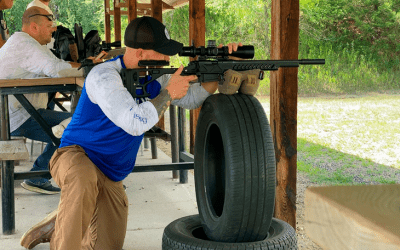
How to get started in competitive rifle shooting
Autor: Chad Anderson
Getting into rifle match shooting or any type of competitive shooting can be intimidating. I can assure you, the worries are much greater than the reality. Unfortunately such worries tend to keep a lot of people away from giving a competition a shot (see what I did there). In fact, it kept me away for quite some time before I decided to give it a try. The shooting community as a whole is very helpful, friendly and most of the time more than willing to help you should you decide to get involve.
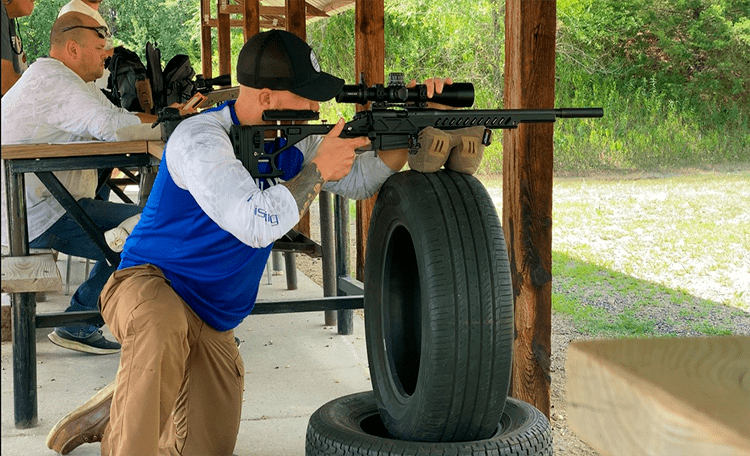
Getting into rifle match shooting or any type of competitive shooting can be intimidating, but making that decision can be rewarding should you decide to move forward with your decision.
Before we get into all of this, this blog is an expression of my own personal experiences and opinion. Every shooter will have their own experience on how they got started, and the opinions of others will greatly differ. So keep that in mind when reading this blog, especially if you’re reading this from another country where firearm rules and regulations are different.
Getting involved is more of a marathon than a sprint. If you feel that it was the right step for you to get involved in the competitive world of shooting, you’ll likely feel the need to go deeper into it as you put in more time and gain more experience to keep up to the challenges and enjoyment it can provide, and that’s quite normal as most of us feel the same way.
The main focus is to help you understand the process of how I got involved and hopefully it can help guide you in the right direction. I won’t go into great details, but I will cover enough of the basic and general understanding to help you get started. I will also talk about the equipment and gears that you will need and how to practice and prepare for your first match based off my own experience.
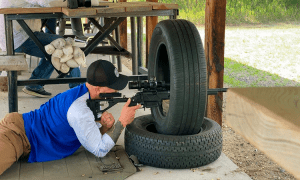
This was a stage at a rimfire (22LR) match recently where I had to shoot from multiple positions off some tires. We had to engage from the top and center of the tire as part of the COF (Course of fire).
First and foremost, when dealing with any firearm or anything that’s gun related, safety should be the number one priority. I am going to leave it at that.
During any competition you can be disqualified (and will likely be disqualified) if you’re not following safety protocols. Before every match and during the safety brief, officials will remind everyone on the conduct of safety and any additional protocols that goes with it base on the style and type of match you’ll be shooting, to include explaining the range layouts to that specific range to identify left and right range limits to ensure everyone understand all these safety rules and guidelines to avoid any accidents or problems before, during or after the match.
There really isn’t a “standard” on the level of experience a shooter should have, or equipment and gear to be able shoot a match, and the only major standard would be cartridge and gun type. There may be some qualifications needed for the pro level and national matches, it may also be different in your country base on what rules and regulations is set in place for competition shooting, but for the local level stuff, especially for me, it’s pretty open for beginners level to the most experienced shooter.
As I mentioned earlier, in this article I will cover just some of the basic things that you need to know or understand,what is involve and where to find resource and assistance to help guide you on the right path. I will keep this as simple as possible without going into a lot of details on regulations, rifles and accessories. Let’s get started!
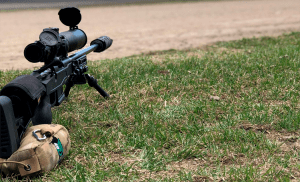
Your shot distances and positions will change depending on the type of match your shooting.
This was a prone position stage (centerfire match) engaging a target at 1350 yards.
1: Getting involved and where to begin;
I highly recommend that you have some kind of basic experience in handling and shooting a rifle safely and correctly.(The cartridge and rifle used will all depend on the type of match you want to do.)It helps that you gain some confidence in your shooting abilities at your local range. Shoot from different positions and at different distances if your range allows you to so. If possible, find a mentor that can help guide you in the right direction. Local gun range is a great place to meet new people that can help guide you on the right path, so don’t be afraid to talk to people.
Do your own research and build off that knowledge, sure recommendations are great from others, but the more you do your own research, the more knowledge you’ll gain to better yourself. Net-working with people at your local gun range that can help you find a match that is right for you is a good place to start and don’t be afraid to sign up for it. Some event will offer a beginner’s match where they will go over general skills, stages, equipment and what a “real” match will entail. When you sign up for a pro/amateur style match you will be paired with a “pro”. You will shoot the match together as a team and you can learn a lot from one of these matches. This is a great way to get involved, meet people and learn new skills. Who knows, maybe at some point you end up being classify as “pro” and end up helping out another new shooter.
You can also watch a match to get comfortable. Just check with the range and match official to make sure this is ok before you decide to attend any match as a spectator. One of best places to find out about these matches is through social media. Try and find a local shooting group on Facebook (or similar) and they can lead you in the right direction. You could also just use a search engine on the internet and dig around for event locations, dates and style of match.The main thing is don’t be intimidated, be willing to learn and ask questions. You will find out that a lot of the people at these events are more than willing to help you get started.
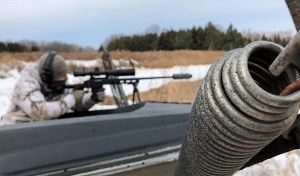
You never know just what kind of obstacle or conditions you’ll be shooting in at these matches, but it’s all part of the fun and provides plenty of challenges.
2: Equipment/Gear;
The main equipment and item you will need to get started is a rifle and ammo (typically between 50-100 rounds for a match).Both centerfire and rimfire are extremely fun to shoot. Typically in centerfire matches you’ll see a wide variety of 6mm and 6.5mm calibers with a velocity limit of 3,200 fps. Reason these are the most common calibers you’ll see is that they are lighter in recoil, especially the 6mm’s, with its nice flat trajectory and consider to be one of the most accurate cartridge out there. Along with the lighter recoil comes the ability to see your shot impact on target or dirt. If you can’t spot the impacts of your shots, it’ll be harder for you to correct that shot to be on target for your next one if you need to adjust.
When talking about rimfire matches it’s almost always about the 22LR caliber. The rimfire matches are essentially a mini version of a centerfire match, very similar stages, just shorter distances and they can be just as challenging. Along with the rifle you obviously need an optic. Optics is a whole other topic in itself, but you want something with exposed turrets that you can easily dial, and at minimum, a mildot style reticle capable of elevation and windage adjustments.
The next items that will be a necessity for your first match will be a front bipod, rear shooting bag and a ballistic calculator. The front bipod can range from a simple easy to use system to the most complex system. Over time you’ll find out what you will need or prefer. If you don’t already have a bipod you could also try and borrow one before making the purchase to test it out and see for yourself if it works for you. A rear bag doesn’t have to be anything expansive and a simple sand sock would suffice and can be upgraded overtime to something like a game-changer which can be used in multiple ways. The bipod and rear bag will be used as support on many of the stages you will encounter.
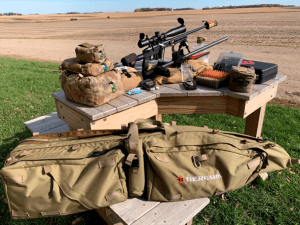
Gears can vary quite a bit from person to person and match to match. Know what you need or don’tneed and go from there.
A ballistic calculator can be as simple as an app that can be installed in your apple or android phone (ballistics ARC is a great one). You will enter your ammunition information, some simple rifle/optic information and it will calculate/estimate your elevation and windage for different distances, wind speed and directions. In order for these apps to work as it should, you need to provide the most accurate information you can for it to provide you with the best data, the more accurate it is, the less you will need to calculate. You will still need to go out and shoot to test the info that was calculated and adjust as needed. It’s also nice to get a real velocity reading with a chronograph, but the velocity listed on the ammo will be somewhat close enough for your first match.These items are the minimum I would recommend, and will help get you through your first match.
Once you have shot your first match you will likely know right away if it’s right for you. If it is, you’ll dive deeper into the world of competitive shooting tobetter yourself for your next match. Different types of bags, tripods, slings, barricade stops, kestrel/wind speed gauge, chronograph, binoculars, and range-finder are all part of the process and equations of what you need to be ahead of your competitors. These items are considered goodies that are nice and helpfulto have, but not mandatory to have.Many of these items has a dual purposes use for either match shooting or for hunting. With that mentioned, all of that decision will be base off personal preference if it is right for you.
3. Practice and follow up;
After you have shot your first match you will have learn quite a bit already and have a better understanding on what you need work on. One of the easiest ways to practice, and this can be done at home is “dry fire” exercise. Remember safety comes first. (MAKE SURE YOUR WEAPON IS UNLOADED) This can be done in the garage or in your basement. Dry fire is doing exactly as it sounds, you’re firing and running the bolt of your weapon (unloaded). You can do this in multiple positions, aiming at various targets that you have set-up within the space. For around 50 dollars you can pick up dry fire practice adaptor/devices. Typically, these look like an objective lens scope cap and help make the view through your scope at ranges of like 10 feet a lot easier. They will come with pictures of shooting ranges/targets you can aim at while dry firing from different positions.
Obviously, the best way to practice is to get out there and shoot as much as you can from match positions at various distances. Unfortunately not all gun range will let you shoot in certain position due to safety reason, but any trigger time is better than no trigger time and will always provide good practice.
When you’re out shooting (or even dry firing) try to film yourself. By watching yourself shoot and going through the dry firing exercise you can see exactly what you need to work on. Whether it’s your trigger squeeze, rushing a shot, flinching, or bad positioning, watching a review of your own film can greatly help you correct those flaws.
Other resource to take into consideration to help yourself improve is to find some books, there’s plenty of online resources and it’s practically free to read up on. One of the first books I bought about competitive and long range shooting was “Long Range Shooting Handbook” by Ryan Cleckner. He goes into great detail to explain all the important factors to consider and provide tons of knowledge in an easy reading format. The book is definitely worth checking out.
Rimfire rifles are also a great way to practice for not only the obvious reason (rim fire matches), but for centerfire practice as well. Sure the distance is greatly reduced, but the cost saving on ammo and how much practice you can get in with it is really beneficial. You can set up your 22LR as a “trainer” and mimic the weight and size of your centerfire. Rimfire matches have recently become quite popular and growing more and more every year. Combining these two styles of shooting has helped a lot of shooters become more proficient in their shooting disciplines.
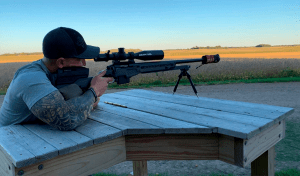
The 6mm Creedmoor is my cartridge of choice for my centerfire match rifle. In this photo I am doing a little practice and gathering some dope (data on previous engagement) for different ranges.
4: Final Thoughts;
Some match you don’t need any special rifle, you could also use your hunting rifle chambered in .308 or any other cartridges you’re familiar with. However, if you would like to get more involve and be more competitive, you will want a rifle geared towards precision rifle shooting or any other shooting discipline you have an interest in. The rifle should be capable of producing 1 MOA accuracy (1” group at 100 yards). You will also need a quality scope capable of repeatable tracking for windage and elevation adjustments with a “hold” capable reticle. You don’t have to break the bank to get started. Do your own research and you can find some great deals on some of these items.
Taking a class and investing in some time to understand the type of shooting and competition you want to do is always great and worth it in my opinion. Getting out and shooting with an instructor is probably the best way to learn. Practicing on your own and researching to find information is all part of the fun and enjoyment that goes into this style of shooting. Don’t let fear of the unknown get in the way to prevent you from competing in your first match. Most shooters that are doing competition shooting are more than willing to help you get started, and they can also provide training tools and accessories for you to borrow before you buy. Over time, if you truly enjoy the competition and the challenges it offers, you will grow into the sport and feel more comfortable.
In closing, I hope this blog will help guide most of you to your first match, or encourage more of you to just get out there and have fun. Just remember that every competitive shooter had to start from somewhere, so have fun in all of this if you decide to move forward and give it a try.
About the author:
Chad Anderson is a Bergara North America Pro-Staff. He is also the admin for the “Bergara Experience” and “Bergara Enthusiasts” Facebook groups and a blog contributor. Chad is a hunter and competitive shooter from the United States with a great understanding and passion for the sport.
Email: [email protected]
Instagram: @chadandy12
